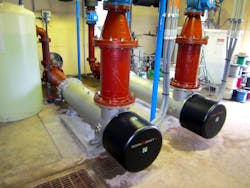Ultraviolet Technology Helps Pennsylvania Town Meet Groundwater Regulations
The Hall Road Well Station is located in Abington, Pa., approximately 12 miles (20 km) north of Philadelphia. The site is designed to extract and treat 1.5 million gal per day (mgd) of water from the Piedmont and Blue Ridge crystalline-rock aquifers. It is also part of a network of groundwater extraction wells owned and operated by Aqua-America Pennsylvania (Aqua PA) which delivers more than 22 mgd of treated groundwater to end users in southeast Pennsylvania.
In 2009, the Pennsylvania Department of Environmental Protection (PADEP) introduced legislation requiring mandatory 4-log virus disinfection for all groundwater extraction and treatment sites in the state. This legislation is similar to federal legislations such as the United States Environmental Protection Agency’s (EPA) Groundwater Rule (GWR) introduced in 2006, which requires groundwater systems to achieve 4-log virus inactivation in the event that the source water contains or is exposed to pathogens including Escherichia coli, enterococci or coliphages. However, the PADEP requirement is different in that it mandates 4-log inactivation of viruses regardless of whether or not a contamination event has occurred.
In response, many groundwater providers have made efforts to improve chlorine-based disinfection. This is primarily accomplished by expanding existing contact tanks and/or installing new tanks or installing oversized pipes or pipe loops to increase chlorine contact time. However, solutions such as these would have been difficult for the space-constrained Hall Road Well Station, which would have required approximately 430 ft of additional 36-in. diameter pipe. Aqua PA decided that a solution with a smaller footprint was required.
The UV Solution
TrojanUV recognized the contribution ultraviolet (UV) technology could potentially make to virus treatment. UV disinfection is instantaneous and does not require extended contact times unlike chlorine and other chemical-based disinfection alternatives. As a result, UV can accomplish similar levels of disinfection to chlorine but within smaller space constraints.
Until recently, UV was considered unfavorable for virus disinfection due to the high resistance of certain species of virus (namely adenovirus) to UV. To overcome this, TrojanUV and its validation partner utilized a validation protocol that incorporated a surrogate organism, which, like adenovirus, is highly resistant to UV disinfection. The results were four TrojanUVSwiftSC (Small Community) systems capable of achieving EPA Ultraviolet Disinfection Guidance Manual (UVDGM) mandated doses for inactivating 4-log virus, including adenovirus (186 mJ/cm2) at flow rates of more than 700 gpm through a single reactor. In addition to virus, these four systems were also validated for the inactivation of chlorine-resistant pathogenic microorganisms such as Cryptosporidium and Giardia.
Aqua PA determined that UV technology was the best approach for meeting the PADEP regulations for 4-log virus treatment of groundwater without a significant increase in footprint. TrojanUV recommended that two TrojanUVSwiftSC D12 UV reactors be installed at the Hall Road Well Station each equipped with 12 low-pressure high-output (LPHO) lamps. The installation itself required less than 100 cu ft (less than 3 cu meters) of space, far less demanding than the more than 400 ft of pipe required for enhanced chlorine treatment.
In addition to providing a smaller footprint, UV disinfection was also advantageous as it provided a chemical-free solution, limiting the possible generation of regulated disinfection by-products including trihalomethanes and haloacetic acids.
System Performance
The TrojanUVSwiftSC systems installed at the Hall Road Well Station have been in operation since July 2012 and performance was assessed by way of a performance test conducted from September to December 2012. The system itself was found to be reliable and operated continuously throughout this performance assessment period with no unintended disruptions in service. This reliability was significant considering the installation provides a critical source of potable water for the area.
In addition, the validated dose during system operation was maintained at a level above the minimum UVDGM-required validated dose for 4-log virus treatment of 186 mJ/cm2.
The dose-pacing feature of the system allowed for the automatic adjustment of power output to compensate for increases or decreases in flow rate or water quality in order to maintain the minimum validated dose using as little energy as possible. This feature maintains the system’s operational integrity while minimizing operational costs and adds a measure of environmental sustainability to the system by conserving energy.
Scott Bindner is market development analyst for TrojanUV. Bindner can be reached at [email protected] or 519.457.3400.
